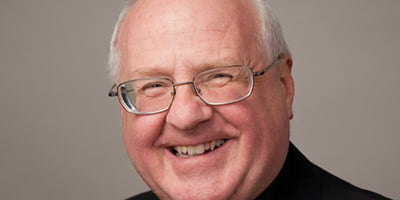
Father Mark Goldasich is the pastor of Sacred Heart parish in Tonganoxie. he has been editor of the Leaven since 1989.
by Father Mark Goldasich
“Hey, Father Mark, I feel like I’m a not-very-good Catholic and should know this,” said a parishioner in a recent phone message. “My question is: What do you do with an old Bible?”
First of all, I quibble with the caller saying she’s not a very good Catholic. Merely coming up with the question above shows a healthy faith instinct. Knowing that the Bible is something holy, this woman didn’t want to just toss it out in the trash. That’s a great first step. Finding out more information is the next one.
Questions like this always remind me that no one can ever know every- thing about Catholicism. With that in mind — and as it’s still Catholic Press Month — I invite you to relax, “take five,” and consider the following books, perfect for deepening your faith in the upcoming Lenten season.
Even feel inadequate to answer even the most basic questions about Catholicism? Worry no more. Liguori Publications has come out with “Catholic and Cornered: Answers to Common Ques- tions About Your Faith,” by Kenneth L. Parker (2011; 96 pgs.; $10). This very readable book is presented in question- and-answer format and deals with a wide range of issues, from the papacy to sacraments and worship to Catholic devotions. Although not intended as an exhaustive resource, it does hit upon many common questions that non- Catholics pose about the church and its beliefs. Everyone will learn something new here.
Reflecting on that “old Bible” question led me to another book that deals with holy “old” things: relics. Thomas J. Craughwell has written a fascinating book called “Saints Preserved” (Image Books, 2011; 313 pgs.; $16). This “authoritative collection of relics from the Catholic Church” is presented in encyclopedia form. Entries are relative- ly brief — from the Aachen Relics to St. Zita — and include where the relic is located today, its history, and a biography of the saint and his or her feast day. Why venerate relics? The author says it well: “Bringing out Grandma’s china for Christmas dinner stirs the emotions and makes us feel connected once again to someone we loved but who has since died. Relics work in the same way but more intensely, because in the case of sacred relics the connection is not only to someone we love but to someone who was genuinely holy.” This book will have you saying more than once, “I had no idea!”
A hallmark of the Lenten season is prayer, but many of us get into ruts when praying, making our time with God stale and lifeless. If this describes you, then pick up a copy of “28 Differ- ent Ways to Pray,” written and edited by members of the Spirituality Committee of the Federal Association USA of the Sovereign Military Hospitaller Order of St. John of Jerusalem, of Rhodes and of Malta (Paulist Press, 2009; 142 pgs; $12.95). This practical book opens up the treasury of Catholic prayer forms. It covers familiar items like the Mass, the rosary and eucharistic adoration, but also directs readers to explore lesser-known prayer styles, such as lectio divina, icons and art, poetry and song, and even modern media. The introduction of the book states: “Just as there is no single ‘best’ form of prayer, so also there is no universal way to pray, no one-size-fits-all structure. We are all different, and we all relate to God somewhat differently. We must each find our own way.” This book not only describes each prayer form, but also guides a reader through it and provides additional resources to delve deeper.
I hate to say this, but many times it seems that Mass-goers “tune out” the second reading at Mass. I under- stand. It’s usually from St. Paul and can be difficult to follow. However,
this prolific letter writer has much to teach us about faith, prayer and life. That’s why Joseph Durepos has written “A Still More Excellent Way: How St. Paul Points Us to Jesus” (Loyola Press, 2008; 118 pgs; $10.95). The book makes Paul accessible and appreciated and is very readable and understand- able. Durepos begins each very short chapter with a few verses from one of Paul’s letters, followed by a short meditation. The author hopes that Paul will “rearrange your priorities, cause you to think about things differently, and generate more patience, courage, and faithfulness in your life.”
Lastly, we spend the bulk of our lives (it seems) at work. And sometimes that is a big burden to carry. Authors Mike Aquilina and Father Kris Stubna want to change that with their mini-sized book, “Take Five: On-the-Job Meditations with St. Ignatius” (Our Sunday Visitor, 2008; 175 pgs.; $9.95). Each of the brief 74 work meditations — such as Don’t Procrastinate; Learn to Listen; Asking for a Raise; Sick Days — consist of a snippet of the saint’s writing, brief questions for reflection, a passage of Scripture and a sentence to memorize and carry throughout the day. It may not make the workday pass any faster, but it will make it more prayerful and meaningful.
So, what do you do with an old Bible? You can burn it, bury it or donate it — so long as it’s treated with respect. But you knew that already, right?

